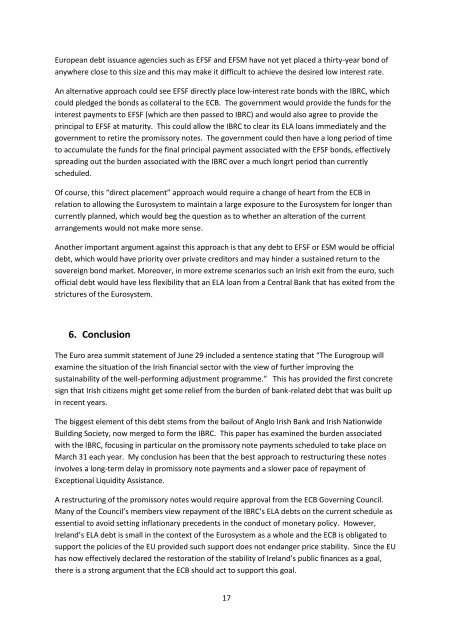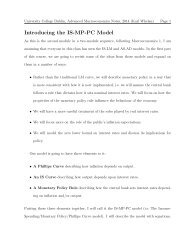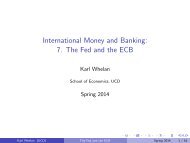ELA, Promissory Notes and All That: The Fiscal Costs ... - Karl Whelan
ELA, Promissory Notes and All That: The Fiscal Costs ... - Karl Whelan
ELA, Promissory Notes and All That: The Fiscal Costs ... - Karl Whelan
You also want an ePaper? Increase the reach of your titles
YUMPU automatically turns print PDFs into web optimized ePapers that Google loves.
European debt issuance agencies such as EFSF <strong>and</strong> EFSM have not yet placed a thirty-year bond of<br />
anywhere close to this size <strong>and</strong> this may make it difficult to achieve the desired low interest rate.<br />
An alternative approach could see EFSF directly place low-interest rate bonds with the IBRC, which<br />
could pledged the bonds as collateral to the ECB. <strong>The</strong> government would provide the funds for the<br />
interest payments to EFSF (which are then passed to IBRC) <strong>and</strong> would also agree to provide the<br />
principal to EFSF at maturity. This could allow the IBRC to clear its <strong>ELA</strong> loans immediately <strong>and</strong> the<br />
government to retire the promissory notes. <strong>The</strong> government could then have a long period of time<br />
to accumulate the funds for the final principal payment associated with the EFSF bonds, effectively<br />
spreading out the burden associated with the IBRC over a much longrt period than currently<br />
scheduled.<br />
Of course, this “direct placement” approach would require a change of heart from the ECB in<br />
relation to allowing the Eurosystem to maintain a large exposure to the Eurosystem for longer than<br />
currently planned, which would beg the question as to whether an alteration of the current<br />
arrangements would not make more sense.<br />
Another important argument against this approach is that any debt to EFSF or ESM would be official<br />
debt, which would have priority over private creditors <strong>and</strong> may hinder a sustained return to the<br />
sovereign bond market. Moreover, in more extreme scenarios such an Irish exit from the euro, such<br />
official debt would have less flexibility that an <strong>ELA</strong> loan from a Central Bank that has exited from the<br />
strictures of the Eurosystem.<br />
6. Conclusion<br />
<strong>The</strong> Euro area summit statement of June 29 included a sentence stating that “<strong>The</strong> Eurogroup will<br />
examine the situation of the Irish financial sector with the view of further improving the<br />
sustainability of the well-performing adjustment programme.” This has provided the first concrete<br />
sign that Irish citizens might get some relief from the burden of bank-related debt that was built up<br />
in recent years.<br />
<strong>The</strong> biggest element of this debt stems from the bailout of Anglo Irish Bank <strong>and</strong> Irish Nationwide<br />
Building Society, now merged to form the IBRC. This paper has examined the burden associated<br />
with the IBRC, focusing in particular on the promissory note payments scheduled to take place on<br />
March 31 each year. My conclusion has been that the best approach to restructuring these notes<br />
involves a long-term delay in promissory note payments <strong>and</strong> a slower pace of repayment of<br />
Exceptional Liquidity Assistance.<br />
A restructuring of the promissory notes would require approval from the ECB Governing Council.<br />
Many of the Council’s members view repayment of the IBRC’s <strong>ELA</strong> debts on the current schedule as<br />
essential to avoid setting inflationary precedents in the conduct of monetary policy. However,<br />
Irel<strong>and</strong>’s <strong>ELA</strong> debt is small in the context of the Eurosystem as a whole <strong>and</strong> the ECB is obligated to<br />
support the policies of the EU provided such support does not endanger price stability. Since the EU<br />
has now effectively declared the restoration of the stability of Irel<strong>and</strong>’s public finances as a goal,<br />
there is a strong argument that the ECB should act to support this goal.<br />
17

















